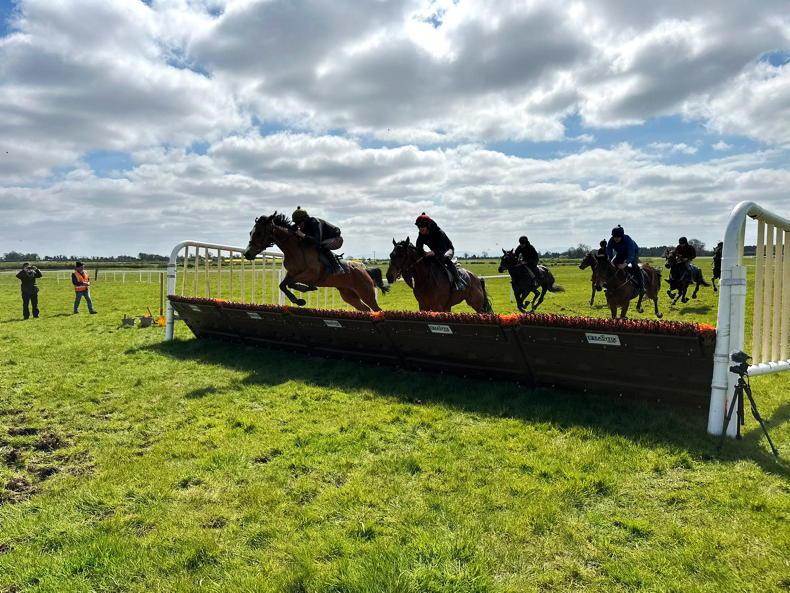ATTENDING a morning of schooling races at Fairyhouse Racecourse bears a little resemblance to what you’d imagine it’s like to stand between the runways at Heathrow Airport in the height of summer travel.
Horses – some of them potentially equine aeroplanes – are everywhere and seemingly going in all directions. A total of 202 runners to be exact. No racecards, no colours, no commentary, no crowds, no idea of which horses are racing against each other and no recorded results or weights. The constant flow of races is relentless. Seven schooling hurdles and five schooling bumpers are run within roughly three hours - eat your heart out, tracks who consistently are off late when still having the benefit of 35-minute gaps between races on a standard card!

Field sizes are big, averaging out at just shy of 17 per race, and the educational benefit for young horses is undeniable. Their value is evident by some of the names involved in these mornings, with Gordon Elliott, Gavin Cromwell, Joseph O’Brien and Jessica Harrington among the top operations with horses schooling at the Co Meath track on this particular Tuesday.
Fairyhouse manager Peter Roe is the equivalent of Heathrow’s head of air traffic control on a day like this and surely must cover as many steps as any of last weekend’s London Marathon runners between giving the green light to riders in the parade ring to rushing out to watch the schooling races in the middle of the track.
“Days like these are a lovely education for the young horses,” says Roe.
“It can be a bit of pandemonium with horses everywhere - it keeps me on my toes! The great thing is that we haven’t a clue who the horses are. They could cost €20,000, €200,000 or €800. Nobody is the wiser and trainers like that.”
Fresh innovation
As well as these races serving a purpose in the training preparations of horses, there is also a future-facing element to the morning. In use across the schooling hurdles are seven modernised Easyfix hurdles, made primarily of PPR plastic.
Visually, they give the impression of a traditional timber hurdle - more so than the Easyfix hurdles seen at many tracks on these shores - and the feedback from many involved in riding over them at Fairyhouse was particularly positive.
Easyfix’s co-CEO Niall Earls explains: “The whole idea of these is that they would do everything a traditional hurdle does. There’s the same ash leg going into the ground that’s been going into the ground for 150 years, they function the same when a horse hits them, they move the same, they fall the same way and have all the attributes people expect for modern-day racing.
“You have no splinters, no top-bars breaking, no padding flying around the place - they’re one unit and no horse can put their leg through a hurdle. It’s got artificial birch on top to mimic a traditional hurdle, there’s orange and brown grass, which can alternatively be brown and white based on the region you’re in.
“The legs are replaceable within seconds; that’s the only part of the hurdle that will ever need to be replaced. The whole hurdle can be dismantled in minutes using a simple spanner and can be reassembled quickly. They don’t fall as easily as other hurdles and horses have plenty of respect for them. They jump them very well. The sound from them is distinct, but not louder. We’ve done decibel readings on these and the traditional hurdle, and these are 10% quieter.”
Sustainability angle
From a racecourse economics standpoint, and with sustainability and welfare in mind, Roe believes there is a definite place for the modern hurdle on actual racedays.
“Last year at Fairyhouse, we broke 178 hurdles,” he explains. “If you look at it costing approximately €100 per hurdle, you’re closing in on roughly €20,000 in cost over the course of a year. That takes up time and labour just to get back to where you were. One of the big parts is that ash is coming in from France because we can’t get any more in Ireland due to ash dieback. The fear is that when we’re depending on abroad, it doesn’t make matters straightforward.
“This is our second year to trial what we’re calling Easyfix 3. From an equine welfare point of view, they’re streets ahead of traditional hurdles. Eight to 10 years is the guarantee for them to last. Yes, it’s expensive on day one but, they are the way forward on several fronts.”
Paul Nicholls and Dan Skelton are said to be keen admirers of this Easyfix design, and Gordon Elliott would be happy to see uniformity in racing in terms of the hurdles used.
As it stands, between Britain and Ireland, horses can race over timber hurdles, traditional Easyfix hurdles and padded hurdles of different colours, depending on the country and racecourse.
“We’ve been schooling with them all at home all winter and I’m very happy with them - horses jump them very well,” says Elliott. “Any of the lads I spoke to who rode today are more than happy. They’re presented very well. I like them and would see absolutely no reason why they wouldn’t work on a raceday. You’d like to see consistency.”
Multiple Grade 1-winning rider Keith Donoghue feels similarly.
“I think they ride very well and horses seem to have a lot of respect for them,” he says. “I feel they’ll be a lot safer for horses too than the wooden hurdles. There’s a good noise off them and horses get used to that. You probably would like to see a bit of consistency with what hurdles we have; I wouldn’t be mad about the rubber hurdles and would rather the Easyfix or normal hurdle. Maybe these might replace the normal hurdle as they’re very similar.”
Jessica Harrington was represented at the Fairyhouse schooling races and believes now is the time to advance trials another step closer to racing with the new Easyfix model.
“I like them - there’s a bit more give to them than the original green Easyfix hurdles and I like the look of them, as well as how they stand,” she says.

“There’s no light coming through, which means the likelihood of a horse stepping at them is reduced. I can’t see why they couldn’t work at the races. Visually, they look the part. I know we can be old fashioned with the wooden-style hurdles and we don’t always like change, but I think it’s time we have a trial with them on the track [in a race]. There shouldn’t be humming and hawing or sitting on the fence about it.”
British talks
Earls says the British Horseracing Authority is in the final stage of officially allowing these hurdles to be used on racecourses in Britain, and some tracks there have already signed up to rolling them out whenever approval arrives. Discussions surrounding their use in Ireland does not appear to be at such an advanced stage with the Irish Horseracing Regulatory Board.
“It’s time that we moved on now from what we’ve been doing so far with chopping and changing,” says Earls.
“It’s been trialled comprehensively and hopefully it can get the green light as it’s far better than what is out there currently. A key point is that between various schooling days at Fairyhouse, Thurles, Tipperary, the Curragh and Warwick, a couple of thousand of horses have jumped these hurdles and not one cut, scrape or bruise has been found on any horse from them, as confirmed by senior members of the IHRB veterinary team, who have been inspecting the horses after schooling. The faller rate is also very small.
“There’s no big prize in this for me financially. Our main business is agri and I only get to sell these once. I’m not going to stay running around the country with them forever. It’s doing all the things that people require.”


 This is a subscriber-only article
This is a subscriber-only article
 It looks like you're browsing in private mode
It looks like you're browsing in private mode












SHARING OPTIONS: